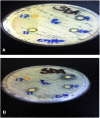Antimicrobial activity and probable mechanisms of action of medicinal plants of Kenya: Withania somnifera, Warbugia ugandensis, Prunus africana and Plectrunthus barbatus
- PMID: 23785437
- PMCID: PMC3681961
- DOI: 10.1371/journal.pone.0065619
Antimicrobial activity and probable mechanisms of action of medicinal plants of Kenya: Withania somnifera, Warbugia ugandensis, Prunus africana and Plectrunthus barbatus
Abstract
Withania somnifera, Warbugia ugandensis, Prunus africana and Plectrunthus barbatus are used traditionally in Kenya for treatment of microbial infections and cancer. Information on their use is available, but scientific data on their bioactivity, safety and mechanisms of action is still scanty. A study was conducted on the effect of organic extracts of these plants on both bacterial and fungal strains, and their mechanisms of action. Extracts were evaluated through the disc diffusion assay. Bacteria and yeast test strains were cultured on Mueller-Hinton agar and on Sabouraud dextrose agar for the filamentous fungi. A 0.5 McFarland standard suspension was prepared. Sterile paper discs 6 mm in diameter impregnated with 10 µl of the test extract (100 mg/ml) were aseptically placed onto the surface of the inoculated media. Chloramphenicol (30 µg) and fluconazole (25 µg) were used as standards. Discs impregnated with dissolution medium were used as controls. Activity of the extracts was expressed according to zone of inhibition diameter. MIC was determined at 0.78-100 mg/ml. Safety studies were carried using Cell Counting Kit 8 cell proliferation assay protocol. To evaluate extracts mechanisms of action, IEC-6 cells and RT-PCR technique was employed in vitro to evaluate Interleukin 7 cytokine. Investigated plants extracts have both bactericidal and fungicidal activity. W. ugandensis is cytotoxic at IC50<50 µg/ml with MIC values of less than 0.78 mg/ml. Prunus africana shuts down expression of IL 7 mRNA at 50 µg/ml. W. somnifera has the best antimicrobial (1.5625 mg/ml), immunopotentiation (2 times IL 7 mRNA expression) and safety level (IC50>200 µg/ml). Fractions from W. ugandensis and W. somnifera too demonstrated antimicrobial activity. Mechanisms of action can largely be attributed to cytotoxicity, Gene silencing and immunopotentiation. Use of medicinal plants in traditional medicine has been justified and possible mechanisms of action demonstrated. Studies to isolate and characterize the bioactive constituents continue.
Conflict of interest statement
Figures





References
-
- Phillipson JD (1994) Natural products as drugs. Trans. Royal Soc. Trop. Med. Hyg. 88 (suppl 1)S17–9. - PubMed
-
- Noor A, Bansal VS, Vijayalakshmi MA (2013) Current update on anti-diabetic biomolecules from key traditional Indian medicinal plants. Current science, vol. 104, no.6.
-
- Schmelzer GH, Gurib-Fakim A (2008) Plants Resources of Tropical Africa. Backhuys Publishers.
-
- Bassam AS, Ghaleb A, Dahoob AS, Naser J, Kamel A (2004) Antibacterial Activities of some Plant Extracts Utilized in Popular Medicine in Palestine. Turkish journal of biology 28: 99–102.
-
- Ivana BS, Mateus LBP, Antonio DV, Riad NY (2006) Antibacterial activity of Brazilian Amazon plant extracts. Brazilian journal of Infectious diseases. 10(6). - PubMed
MeSH terms
Substances
LinkOut - more resources
Full Text Sources
Other Literature Sources

